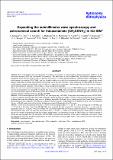Expanding the submillimeter wave spectroscopy and astronomical search for thioacetamide (CH3CSNH2) in the ISM
Author(s)
Remijan, A; Xue, C; Margulès, L; Belloche, A; Motiyenko, RA; Carder, J; Codella, C; Balucani, N; Brogan, CL; Ceccarelli, C; Hunter, TR; Maris, A; Melandri, S; Siebert, M; McGuire, BA; ... Show more Show less
DownloadPublished version (3.088Mb)
Publisher Policy
Publisher Policy
Article is made available in accordance with the publisher's policy and may be subject to US copyright law. Please refer to the publisher's site for terms of use.
Terms of use
Metadata
Show full item recordAbstract
Context. One of the biggest unsolved mysteries of modern astrochemistry is understanding chemical formation pathways in the
interstellar medium (ISM) and circumstellar environments. The detections (or even nondetections) of molecules composed of lowabundance atomic species (such as S, P, Si, and Mg) may help to constrain chemical pathways. Thioacetamide (CH3CSNH2) is the
sulfur analog to acetemide (CH3CONH2) and it is a viable candidate to search for in astronomical environments – specifically toward
regions where other S-bearing molecules have been found and, if possible, that also contain a detection of CH3CONH2. If detected, it
would not only continue to expand the view of molecular complexity in astronomical environments, but also help to better elucidate
the possible formation pathways of these types of species in these environments.
Aims. Our aim is to expand the frequency range of the measured rotational spectrum of CH3CSNH2 beyond 150 GHz and then to
use those measurements to extend the search for this species in the ISM. The new laboratory measurements and expanded search
cover more parameter space for determining under what conditions CH3CSNH2 may be detected, leading to possible constraints on the
formation of large S-bearing molecules found in the ISM.
Methods. The rotational spectrum of CH3CSNH2 was investigated up to 650 GHz. Using the newly refined spectrum of CH3CSNH2,
as well as additional spectroscopic data on the chemically related species CH3CONH2, a variety of astronomical sources were searched
including data from the following large surveys: Prebiotic Interstellar Molecule Survey conducted with the Green Bank Telescope;
Exploring molecular complexity with ALMA conducted with the Atacama Large Millimeter/submillimeter Array; and Astrochemical
Surveys at IRAM conducted with the Institut de Radioastronomie Millimétrique 30 m Telescope.
Results. A total of 1428 transitions from the vt = 0 state with maximum values J = 47 and Ka = 20 in the range up to 330 GHz, and
J = 95 and Ka = 20 in the range from 400–660 GHz were assigned. We also assigned 321 transitions from the vt = 1 state with the
maximum values J = 35 and Ka = 9 up to 330 GHz. We achieved a final fit with a root-mean-square deviation of 43.4 kHz that contains
2035 measured lines from our study and the literature for vt = 0 and vt = 1 states of A and E symmetries. The final fit is based on
the rho-axis-method Hamiltonian model that includes 40 parameters. An astronomical search for CH3CSNH2 was conducted based on
all the new spectroscopic data. No transitions of CH3CSNH2 were detected toward any of the sources contained in our survey. Using
the appropriate telescope and physical parameters for each astronomical source, upper limits to the column densities were found for
CH3CSNH2 toward each source.
Date issued
2022-02Department
Massachusetts Institute of Technology. Department of ChemistryJournal
Astronomy & Astrophysics
Publisher
EDP Sciences
Citation
Remijan, A, Xue, C, Margulès, L, Belloche, A, Motiyenko, RA et al. 2022. "Expanding the submillimeter wave spectroscopy and astronomical search for thioacetamide (CH3CSNH2) in the ISM." Astronomy & Astrophysics, 658.
Version: Final published version